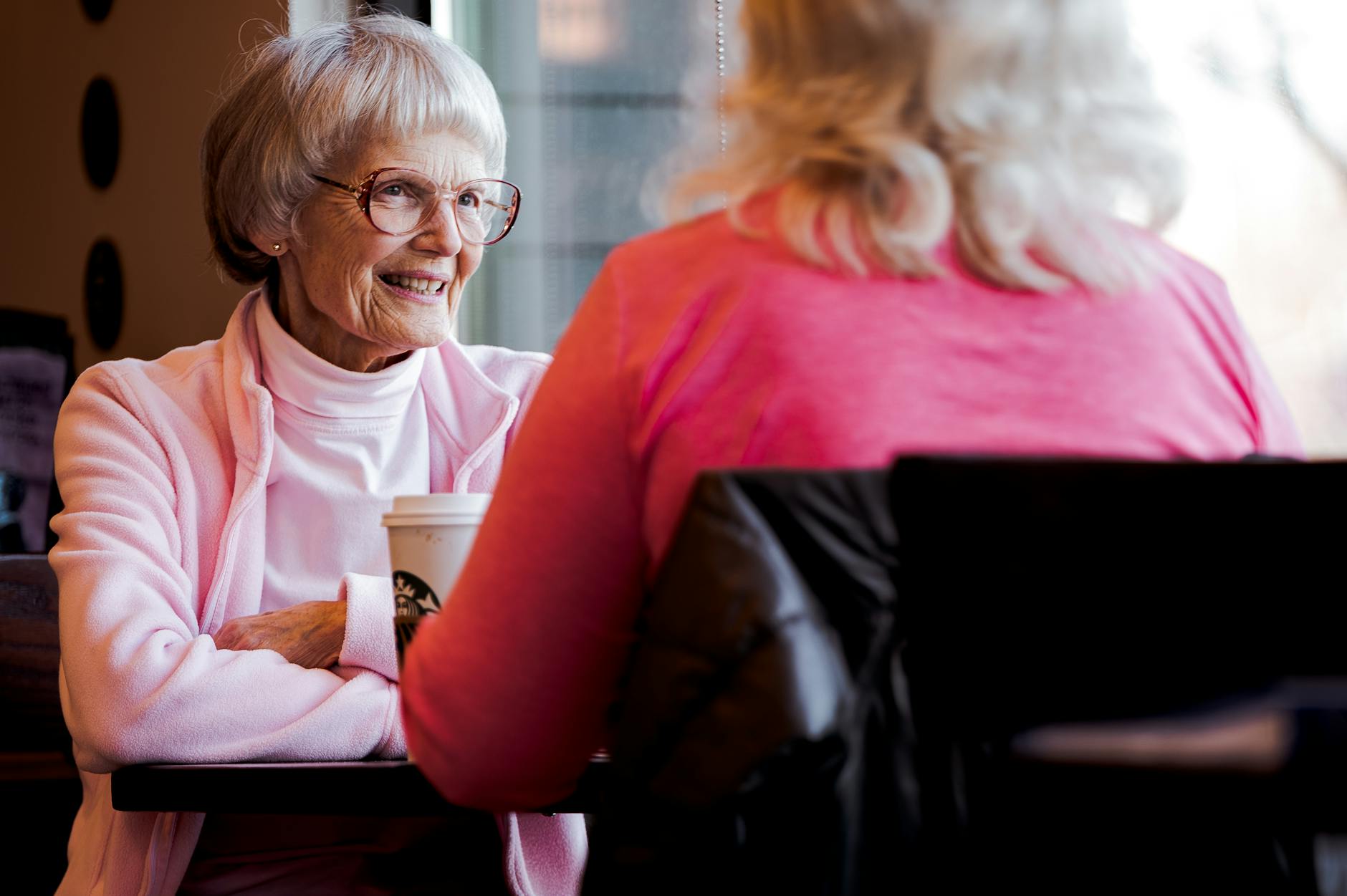Effective Communication With Seniors
Discover strategies, technologies, and tips to connect and engage with your loved ones.
.jpg)
Effective Communication with Seniors
Communication plays a vital role in maintaining meaningful connections with seniors. Effective communication not only helps in understanding their needs and emotions but also promotes their overall well-being. However, there are certain challenges that can arise when communicating with seniors. Let's explore the importance of communication with seniors and the challenges that may arise.

Importance of Communication with Seniors
Elderly individuals often face communication hurdles due to sensory changes like hearing loss, failing eyesight, or an inability to express their thoughts due to the aging process. Maintaining effective communication with seniors is essential for several reasons:
Challenges in Senior Communication
While communication is vital, there are several challenges that can arise when interacting with seniors. These challenges include:
To overcome these challenges, it's important to employ effective communication strategies that cater to the specific needs of seniors. This may involve utilizing technology, employing non-verbal communication techniques, and actively listening to their concerns and preferences. By doing so, caregivers and family members can establish a strong foundation for effective communication with seniors, enhancing their overall well-being.
Enhancing Communication for Seniors
When it comes to effectively communicating with seniors, there are various strategies that can greatly enhance the quality of interaction. By incorporating technology, non-verbal communication strategies, and active listening techniques, caregivers can foster meaningful connections and improve the overall communication experience for seniors.
Technology for Improved Communication
Technology plays a crucial role in improving communication and enhancing the quality of life for older adults. It offers a range of benefits, including increased safety, better medical management, and the promotion of independence and social connections in senior home care.
Health monitoring devices, such as wearable fitness trackers, blood pressure monitors, and telehealth platforms, simplify tracking and monitoring seniors' health. These devices provide valuable data that can assist caregivers in detecting potential health issues early and effectively managing treatment [2].
Safety-enhancing devices, such as Personal Emergency Response Systems (PERS), smart home security systems, and fall detection devices, minimize the risk of accidents and provide prompt emergency assistance when required.
Additionally, technology solutions like video chat software, tablets, smartphones, and social media platforms facilitate connectivity for seniors, allowing them to stay connected with family, friends, and caregivers. This helps reduce feelings of isolation and enhances their social well-being during home care.
Non-Verbal Communication Strategies
Non-verbal communication becomes paramount when verbal communication becomes challenging, especially for individuals with conditions like dementia. Non-verbal communication involves the use of gestures, facial expressions, and body language to convey messages [3].
Caregivers can learn to interpret and respond to non-verbal cues, allowing them to understand the needs and emotions of seniors with dementia. This form of communication becomes particularly important when individuals revert to their first language or when verbal communication is limited. Non-verbal communication strategies help establish a connection and provide comfort, even if the individual does not respond verbally.
Art therapies and activities, such as drawing, painting, music, poetry, and drama, can also assist individuals with dementia in expressing their emotions when verbal communication becomes challenging. These creative outlets provide alternative means for emotional expression and engagement.
Active Listening Techniques
Active listening is a powerful tool when communicating with older adults. It involves giving undivided attention and showing genuine interest in what the senior is expressing. Active listening acknowledges the value of companionship and provides a sympathetic ear for seniors who may feel isolated and longing for social interaction.
Caregivers can practice active listening techniques by maintaining eye contact, nodding to show understanding, and providing verbal cues that indicate attentiveness, such as "I see," "I understand," or "Tell me more." These techniques create a safe and comforting environment for seniors to express themselves and can significantly impact their mental and physical well-being.
By incorporating technology, non-verbal communication strategies, and active listening techniques, caregivers can enhance communication with seniors, promote social engagement, and ensure a more fulfilling and empathetic caregiving experience.
Communication Strategies for Dementia Patients
Communicating effectively with individuals living with dementia requires a unique approach due to the challenges they may face with verbal communication. As the condition progresses, non-verbal communication becomes increasingly important in fostering understanding and connection. In this section, we will explore various strategies that can facilitate effective communication with dementia patients.
Non-Verbal Communication for Dementia
Non-verbal communication becomes the primary way individuals with dementia express themselves as the condition progresses. This form of communication involves gestures, facial expressions, and body language. It can be particularly crucial if the person reverts to their first language, which may not be understood by their caregivers.
When engaging in non-verbal communication with dementia patients, it is essential to maintain eye contact, use gentle touch, and exhibit open and relaxed body language. These actions can help convey empathy, understanding, and a sense of connection, even when verbal communication is challenging.
Art Therapies for Emotional Expression
Art therapies, such as drawing, painting, music, poetry, and drama, can be highly beneficial for individuals with dementia in expressing their emotions when verbal communication becomes difficult. These creative activities provide alternative outlets for emotional expression and can help individuals communicate their thoughts and feelings. Engaging in artistic endeavors can also promote a sense of accomplishment and boost overall well-being.
Sensory Engagement Activities
During the later stages of dementia, verbal communication may be severely limited. In such cases, maintaining communication through touch can play a crucial role in establishing a connection and providing comfort to the individual, even if they do not respond verbally. Simple actions like holding their hand, providing gentle massages, or using textured objects can help convey care and support [3].
Engaging the senses through activities that involve sight, touch, smell, hearing, or taste can also facilitate non-verbal communication and interaction. These sensory engagement activities, as suggested in the activities handbook provided by the Alzheimer's Society, can help stimulate memories, evoke emotions, and promote meaningful connections with dementia patients.
By embracing non-verbal communication methods, incorporating art therapies, and engaging in sensory activities, caregivers can enhance their communication and connection with individuals living with dementia. These strategies provide opportunities for emotional expression, comfort, and meaningful interaction, improving the overall well-being of dementia patients.
Overcoming Barriers in Senior Communication
Effective communication with seniors can sometimes be challenging due to various barriers that may arise. However, there are strategies and solutions available to overcome these barriers and foster better communication. This section will explore technology solutions for seniors, addressing cognitive communication challenges, and avoiding age-related stereotypes.
Technology Solutions for Seniors
Technology has revolutionized communication, and it offers numerous benefits for seniors as well. Video chat software, tablets, smartphones, and social media platforms can greatly assist seniors in staying connected with family, friends, and caregivers, reducing feelings of isolation during home care.
In addition to improving social connectivity, technology can also enhance safety and health monitoring for seniors. Personal Emergency Response Systems (PERS), smart home security systems, and fall detection devices are examples of safety-enhancing devices that can reduce the risk of accidents and provide prompt emergency assistance when required. Health monitoring devices, such as blood pressure monitors and glucose meters, provide valuable data for caregivers to detect potential health issues early and assist in effective treatment management for seniors.
By leveraging technology solutions, caregivers and healthcare providers can enhance the quality of care, promote independence, and augment safety for older adults. The integration of technology in elder care aims to provide a safer, more comfortable, and independent living environment, ultimately enhancing the well-being and quality of life for seniors.
Addressing Cognitive Communication Challenges
One of the barriers in senior communication is cognitive decline, which can impact memory, language, and attention. To address this challenge, it's important to use clear and concise language, avoid complex sentences, and encourage active participation in conversations. Breaking down information into smaller, manageable chunks and using visual aids or written instructions can also aid comprehension.
Additionally, practicing patience and allowing seniors ample time to process and respond to information can help alleviate communication difficulties. It's important to remain attentive, provide reassurance, and avoid interrupting or finishing sentences for them. Showing empathy and understanding can go a long way in fostering effective communication with seniors facing cognitive challenges.
Avoiding Age-Related Stereotypes
Age-related stereotypes can hinder effective communication with seniors. It's essential to approach each individual with respect, acknowledging their unique experiences and capabilities. Avoid making assumptions based solely on age and instead focus on their individual strengths and preferences. By treating seniors as individuals with valuable insights and opinions, we can create a more inclusive and respectful communication environment.
Overcoming barriers in senior communication requires patience, understanding, and the use of appropriate strategies and solutions. By leveraging technology, addressing cognitive challenges, and avoiding age-related stereotypes, we can foster effective and meaningful communication with seniors, promoting their well-being and enhancing the quality of their interactions.
Tailoring Communication for Seniors
When communicating with seniors, it's important to adapt your approach to ensure effective and meaningful communication. Tailoring your communication style can help bridge any generational gaps and foster better understanding. Here are some strategies to consider:
Understanding Seniors' Backgrounds
To communicate effectively with seniors, it's crucial to have an understanding of their backgrounds, including their culture, values, interests, and familiarity with the topic or situation. Recognizing and respecting their experiences and perspectives can help establish a strong connection and build trust. Adapting the complexity of language and providing relevant examples, especially when explaining new technologies, can facilitate better comprehension and engagement.
Choosing Appropriate Communication Channels
Choosing the most appropriate communication channel is vital when interacting with seniors. Different age groups may have varying preferences when it comes to communication methods. While younger generations might lean towards more informal channels like texts or video calls, older generations may value more formal modes such as phone calls or face-to-face meetings. Understanding the preferences of the seniors you are communicating with can help ensure that your messages reach them effectively.
Adapting Tone and Pace
Tailoring the tone and pace of communication is key when engaging with seniors. Adjusting your tone, including your attitude and emotion, and your pace, referring to the speed and rhythm of speech, can greatly impact the effectiveness of your message. While a more casual and dynamic approach might be suitable for communicating with teenagers, a more polite and steady manner may be better suited for interacting with the elderly. Being mindful of the seniors' needs and preferences can help create a comfortable and engaging communication environment.
By considering the backgrounds of seniors, choosing appropriate communication channels, and adapting your tone and pace, you can tailor your communication to effectively connect with and engage seniors. Remember to show respect, empathy, and active listening throughout the communication process. Seeking feedback and clarification can further enhance understanding and ensure that your messages are received and interpreted as intended.
Promoting Well-Being through Communication
Effective communication with seniors plays a vital role in promoting their overall well-being. By establishing clear and meaningful connections, caregivers can enhance seniors' quality of life and provide the support they need. In this section, we will explore the impact of effective communication, engaging seniors socially, and providing comfort and support.
Impact of Effective Communication
Regular and genuine communication, along with active listening, can have a significant positive impact on the well-being of seniors, contributing to their overall health and happiness. Studies have shown that engaged seniors experience less anxiety and depression, fewer chronic illnesses, and better cognitive health, highlighting the importance of maintaining communication with seniors.
By actively communicating with seniors, caregivers can address their emotional and social needs, fostering a sense of belonging and connection. Effective communication also allows for the identification of any potential issues or concerns, enabling prompt intervention and support.
Engaging Seniors Socially
Engaging seniors socially is an essential aspect of communication that contributes to their overall well-being. Seniors want information about various topics, such as housing, transportation, employment, legal matters, retirement planning, health, nutrition, and more. By facilitating conversations on these subjects, caregivers can help seniors stay informed, connected, and involved in their communities.
Encouraging seniors to participate in social activities, such as group outings, hobby clubs, or community events, can also provide opportunities for them to interact with peers and build meaningful relationships. This social engagement not only combats feelings of loneliness and isolation but also promotes mental and emotional well-being.
Providing Comfort and Support
Effective communication with seniors involves providing comfort and support. Caregivers should prioritize creating a safe and nurturing environment where seniors feel valued and heard. This can be achieved by actively listening, showing empathy, and being patient in conversations.
Caregivers should also consider using clear and plain language when communicating with seniors, avoiding jargon or complex terms. Materials and information should be presented in an easily understandable format, with good design and accessible formats. By adapting communication styles to suit the needs of seniors, caregivers can ensure that information is effectively conveyed and understood, promoting a sense of comfort and security.
In summary, effective communication with seniors has a profound impact on their well-being. By engaging them socially, providing comfort and support, and promoting active listening, caregivers can enhance seniors' quality of life and contribute to their overall health and happiness. By considering seniors' interests, needs, and preferences, caregivers can foster meaningful connections and create an environment that promotes their well-being.
References
[2]:
[3]:
[4]:
[5]:
[6]:
[7]:


































































































